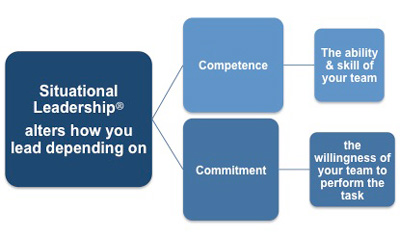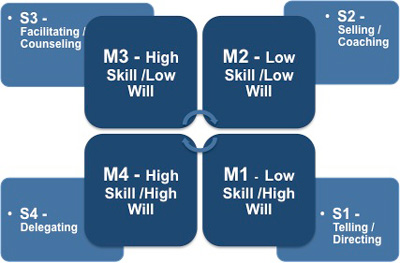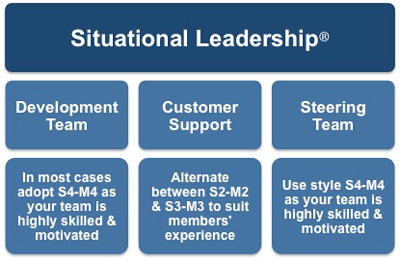Situational Leadership Definition
In contrast to the static nature of the environment required for both transactional and transformational leadership, you may find the ethos behind Situational Leadership® better suited to the needs of your day-to-day team management.
Situational Leadership® is a registered trademark of the Center for Leadership Studies, Inc. - www.situational.com
The Situational Leadership® model was developed in the early 1980s by Ken Blanchard and Paul Hersey. This model states that there is no single style of leadership that is effective in all circumstances.
 |
The most successful leaders and managers adapt their leadership style depending on the 'competence' and 'commitment' of the group, team, or individual being led.
As a manager you would alter your style to suit the ability of your team whether high or low (Competence) combined with the willingness or motivation of the team to do the task (Commitment), which is also either high or low. This offers you four possible combinations of what the model refers to as Maturity Levels (M1-4). These are listed below, together with a brief explanation about how a team at this level operates.
Maturity Level 1 (M1) - Low Competence/Skill & High Commitment/Will
Your team would lack the ability to do the task you set them, but the members would be enthusiastic and willing to overcome this in order to complete the task.
Maturity Level 2 (M2) - Low Competence/Skill & Low Commitment/Will
At this level your team would still lack the ability to do the task, but the members would display no enthusiasm or willingness to overcome this lack of knowledge.
Maturity Level 3 (M3) - High Competence/Skill & Low Commitment/Will
This team is capable of performing the task but shows no willingness to actually do it.
Maturity Level 4 (M4) - High Competence/Skill & High Commitment/Will
This is a desirable team, as it is both able to complete the task and displays an enthusiasm and willingness to do so.
Within these four options at any one time, whether you look at the maturity levels vertically or horizontally, there is always a constant. On the vertical axis the level of skill is constant and on the horizontal axis the level of willingness is constant, whether you look at the top or bottom pair.
These Maturity Levels are also task-specific. So if you ask a team that normally has a maturity level M4 (High Skill / High Will) to perform a task it do not have the skills for it will have a maturity level M1 (Low Skill / High Will) for that particular task, and you will have to adapt your leadership accordingly.
 |
For each 'M' (Maturity) level there is a most effective leadership style you can adopt. This style not only suits the team or person you are managing but the task, role, or function that is required. The Situational Leadership® model suggests that there are four leadership styles (S1 to S4), which map onto the maturity levels (M1 to M4) of the team respectively.
Leadership Style S1 - Telling and Directing for M1 (Low Skill & High Will)
To successfully manage this type of team you harness the team's enthusiasm to overcome their lack of knowledge. You would need to give explicit instructions throughout the task, telling your members exactly what their roles are, plus how and when to accomplish the task.
Leadership Style S2 - Selling and Coaching for M2 (Low Skill & Low Will)
With this type of team you need to 'sell the task' and actively communicate with the members to provide the necessary information. You must provide the direction and the emotional support that will influence the team sufficiently to buy into the process, and be motivated to complete it.
Leadership Style S3 - Facilitating and Counseling for M3 (High Skill / Low Will)
Managing this team requires you to focus more on the relationship, sharing the decision-making and motivating the team to accomplish the task. Your team possesses the necessary skills but lacks the willingness to actually do it.
Leadership Style S4 - Delegating for M4 (High Skill / High Will)
Your role with this team is to monitor progress, allowing the members to use their ability and enthusiasm to manage the process and decision-making in order to complete the task.
There are two other leadership styles that you should be familiar with: Transactional Leadership and Transformational Leadership.
Applied to the Team Examples
You can see that leadership styles S1 and S2 are best suited to situations where the focus is on getting the task done. But if your circumstances are more concerned with developing team members' abilities to work independently, leadership styles S3 and S4 are the ones you need to adopt.
 |
For each of our team examples you would adopt the leadership style best suited to its function and situation.
Development Team
For this team, leadership style S4-M4 would be most appropriate as the team is well motivated and all of the team members are keen to add another successful project to their resumes.
Your role as manager is mainly one of monitoring, but in some instances or for certain individuals you may need to alter to S1-M1 if the skill levels require such a change. For example, you could be asked to join another project team that is mired in problems for a few weeks. You might then ask a competent member of you team to stand in for you, but whilst they are technically skilled they lack the experience of project management.
 |
Customer Support Team
As Customer Support Manager you will have to be more adaptive in your leadership style as in most instances it will relate more to the individual than the task. You will probably find that for the majority of your time you oscillate between styles S2-M2 with your newer members who have low skill and little motivation, and style S3-M3 as you try to ensure your more experienced members participate, and try to motivate them to perform well.
Steering Team
Your management style for the Steering Team is almost certainly S4-M4 as your whole team comprises highly skilled and knowledgeable individuals who are all extremely self-motivated. These individuals need you to encourage and promote creativity to ensure that innovative and sound business decisions result from the team's activities.
Situational Leadership® shows you that your team will be most successful when you adapt your leadership style to suit the team and situation. There is no one style that is optimal for you to use all the time. As an effective leader you need to be flexible and adapt yourself to the situation.
You may also be interested in:
Team Leadership Theories | Leadership Theories and Management | Different Leadership Styles | Transactional Leadership | Transformational Leadership | Leadership Continuum.



